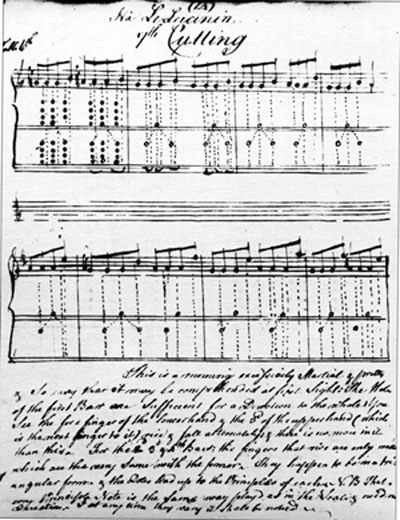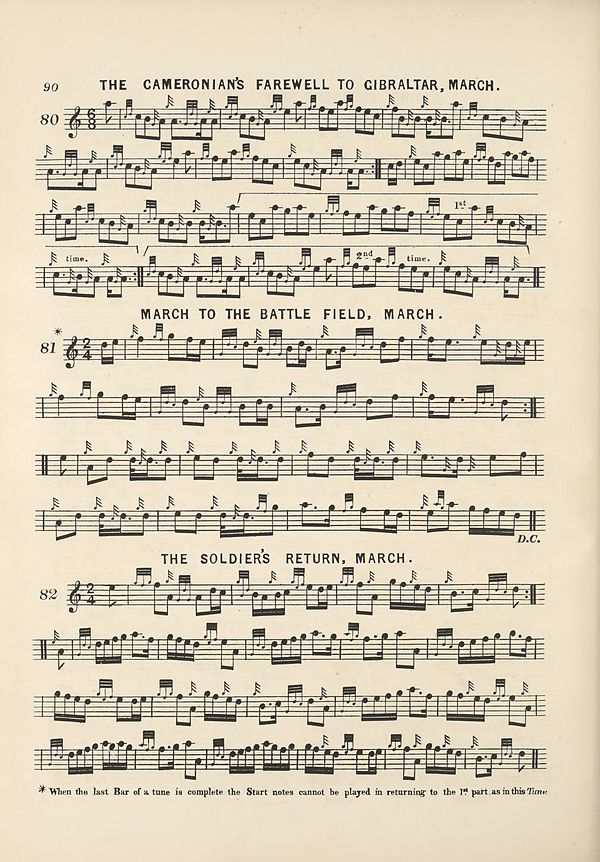|
-
22nd May 17, 03:23 PM
#11
 Originally Posted by slothead

I'm not a piper and have never even seen pipe music so is it written much like any music (piano or otherwise) with staffs, clefs, notes and rests, or is it peculiar to the pipes? (The reason I ask is because I am a guitarist and there is a new method - new to an old fart like me anyway - that is called "tabs" that is written from the perspective of the strings and fingers.)
I'll take a whack at this question. Yes, pipe music is written out in staffs, measures, clef, etc. That being said, this is much of modernizing an ancient means of teaching, learning and playing the pipes from the old days, when it was all done orally (OK, steady on here.) You learned the tune through the singing of it and applied the playing after the tune was memorized in this manner. I suppose the Highlands, being relatively remote and removed, developed this method out of a necessity. The method is called canntaireachd (CAN-terr-ach <pronounce last syllable in the throat like the 'ch' in loch>) and is still being used today, in a limited, artisinal manner. When the European style of staffs, notes and measures overtook all of music, the piping music began to be transcribed into that mode. Tabs on stringed instruments might be considered analogous to the parts of canntaireachd after the memorization of the sung tune was transposed to the actual physical act of playing the tune on the pipes. If you look here: http://pipetunes.ca/digging-deeper/p...rn-manuscript/ you can see an attempt to transcribe the canntaireachd to the written word. Each note and piping ornamentation has its own distinct sound in the 'singing' of the tune and what you see is a literal recording of each sound a canntaireachd singer produced (kind of like a court reporter.) There you go, Slothead, now it's clear as mud. 
JMB
-
-
22nd May 17, 03:35 PM
#12
 Originally Posted by Blupiper

I'll take a whack at this question... If you look here: http://pipetunes.ca/digging-deeper/p...rn-manuscript/ you can see an attempt to transcribe the canntaireachd to the written word. Each note and piping ornamentation has its own distinct sound in the 'singing' of the tune and what you see is a literal recording of each sound a canntaireachd singer produced (kind of like a court reporter.) There you go, Slothead, now it's clear as mud. 
Thanks for that Blup', That is VERY interesting notation. It certainly seems very "compressed" with all those 'notes' represented by a couple flowery 'pictograms' (for lack of a better term). Thanks for your attempt to edumacate me.
Regards,
Tom
-
The Following User Says 'Aye' to slothead For This Useful Post:
-
23rd May 17, 05:32 AM
#13
 Originally Posted by slothead

I have never seen pipe music so is it written much like any music (piano or otherwise) with staffs, clefs, notes and rests, or is it peculiar to the pipes?
That question, as alluded to above, is more complicated that it might seem.
The basic answer is "yes", it is written much like normal music with staffs, clefs, and notes. What you don't have is rests, because the pipes sound continuously.
Pipe music has been set down in ordinary staff notation since the mid-18th century at least, here in 1760:

The Highland Society of London has manuscripts of piobaireached in staff notation from the beginning of the 19th century.
Later in the 19th century a large number of books of pipe music in staff notation were published. The large pipemaking family Glen published many collections starting in 1840.
Here is a page from the Ross Collection (1869). Note the typical pipe ornaments and the lack of key signature.

From the second half of the 19th century onward to today the Highland pipe scene is dependent on published music, to an almost obsessive degree.
For example, here's a track listing from a CD of The World Pipe Band Championships:
10. Medley
Poacher's Paradise (R Durrant- Focus Music LTD)
The Curlew (Trad-PD)
The Old Wife Of The Mill Dust (Trad-PD)
Classical Bob (N Dickie arr R Mathieson-Isa Music)
Maggie Cameron (Trad-PD)
Mrs Donald MacPherson (D MacPherson-D MacPherson)
Wee Harry's Reel (A Mathieson-Cop Con)
The Gravel Walk (Trad-PD)
So the traditional Public Domain stuff is listed as such. Newly composed stuff (which often makes up the majority of the repertoire of modern Pipe Bands) gives the composer, arranger, and publisher.
The interesting thing is the "Cop Con" (copyright control) meaning the composer isn't represented by a publisher.
About the way pipe music is written, up until recently it was common to leave off the Key Signature, which is two sharps.
Since pipers in the old days stuck to the traditional 9-note diatonic scale putting in the key signature was superfluous.
Nowadays the key signature is nearly always used, which has been driven by two things
1) the using of computer programmes which read literally what is on the page, and if you leave out the key signature the computer plays all the Fs and Cs natural.
2) numerous modern compositions using the chromatic possibilities of the Highland chanter, which require that all the sharps and naturals be correctly notated.
So, any fiddler or whomever can sightread any piece of modern pipe music and play it more or less the way the pipes would play it.
Then there are all the ornaments. Usually when pipe tunes are played by fiddle, accordion, or whatnot the ornaments are left out, or sometimes an analogous ornament more suited to the particular instrument is used.
The Highland pipe classical music, Ceol Mor or Piobaireached, has all sorts of complex ornaments. Here are a few. These don't translate to any other instrument, seems to me.

(Odd that they put in a key signature of one sharp, probably because these examples don't happen to have any Cs.)
Two things to keep in mind are Key, and Pitch.
The Highland pipe chanter is in the key of B flat Mixolydian (or E flat Major if you prefer) giving the notes
Ab Bb C D Eb F G Ab Bb
however pipe music has always been written a semitone lower, in A Mixolydian (D Major)
G A B C# D E F# G A
So Scottish Smallpipes in A play normal Highland sheet music at pitch, while the Highland pipes play it a semitone higher. Guitarist usually use a capo at the first fret when playing with the Highland pipes.
The other issue is pitch.
When I started playing, in the 1970s, Highland pipe chanters were pitched around Concert Pitch, Concert B flat. It's great for playing with Pipe Organ, or brass ensembles, or orchestras, or rock bands, or what have you.
Then around 1980 the pitch began creeping gradually upwards, and it may keep creeping up, who can say. Currently most pipe bands play at a pitch which is more or less a quartertone between B flat and B natural, decidedly unfriendly for playing with other musicians.
So, nowadays chanters are available in modern pitch and in Concert Pitch/Concert B flat. Many solo pipers and quite a few pipe bands maintain chanters at both pitches, the sharp ones for playing in pipe competitions and the flat ones for playing gigs with orchestras etc.
Last edited by OC Richard; 23rd May 17 at 05:51 AM.
Proud Mountaineer from the Highlands of West Virginia; son of the Revolution and Civil War; first Europeans on the Guyandotte
-
The Following User Says 'Aye' to OC Richard For This Useful Post:
-
23rd May 17, 06:58 AM
#14
Wow thanks Richard! What a good, detailed explanation. And of course you're right about the Key. Is it always the same (since you can't easily change the drones - can you?) and you certainly can't direct the drones to rest 
Thanks again,
Regards,
Tom
-
The Following User Says 'Aye' to slothead For This Useful Post:
-
23rd May 17, 11:13 AM
#15
Great response and well explained, as always, Richard. Good point with the near obsessiveness of the printed sources of music from the 18th Century onward. I have always felt that when you combined the British Army's detail orientation with the Scot's orderliness and rules adherence, you would get what you commented about in pipe music. The ceol mhor (or piobaireachd), even more so. There are so many "unwritten" rules and a certain pedantic nature of those who oversee that part of the piping world, it can get a wee bit ossified. I'll get off my soapbox now. Thanks for the excellent response and examples, Richard. 
JMB
-
-
24th May 17, 07:49 PM
#16
 Originally Posted by slothead

Is it (the key) always the same (since you can't easily change the drones - can you?) and you certainly can't direct the drones to rest
You bring up an interesting aspect of most piping traditions: playing in a number of keys over a fixed drone.
So, thinking of the written pitch of Highland pipe music (A Mixolydian or D Major, that is, two sharps in the key signature) the following keys/modes are relatively common, all played over the A drones:
A Mixolydian
B minor
D Major
E dorian (that is, a minor scale with a raised 6th)
G Lydian (that is, a Major scale with a raised 4th)
This last is perhaps the oddest, but is very old and deeply rooted in Highland pipe tradition. Many old piobaireachds, strathspeys, and reels are in G Lydian and modern composers are still generating new tunes in that key.
It has odd tonality in another way: the Tonic chord is G Major, the Dominant chord is A Major.
Most if not all of these tonal centres are used for various gap scales, which can give the effect of a key the pipes don't actually produce.
The most often-heard example are the vast number of tunes which the ear hears as being in A Major. In fact these tunes have no G's in them, so strictly speaking they're neither Major nor Mixolydian, but the impression is of a Major scale.
The Irish uilleann pipes, the French cabrette/cornemuse, the Bulgarian gaida, and so forth all play in a similar number of different keys over the same fixed drone note.
By the way, I was reading something about modern scholars being confused about mediaeval choir music, where two choirs were trading off singing in two different keys, and a fixed drone was mentioned. It dawned on the musicologists that the drone was playing the Tonic of neither choir.
You can imagine the effect when you think of one piper playing a tune in D Major with a drone at the 5th, and another piper playing in G Lydian with a drone at the 2nd, both drones being the same note, A.
Proud Mountaineer from the Highlands of West Virginia; son of the Revolution and Civil War; first Europeans on the Guyandotte
-
 Posting Permissions
Posting Permissions
- You may not post new threads
- You may not post replies
- You may not post attachments
- You may not edit your posts
-
Forum Rules
|
|




















Bookmarks